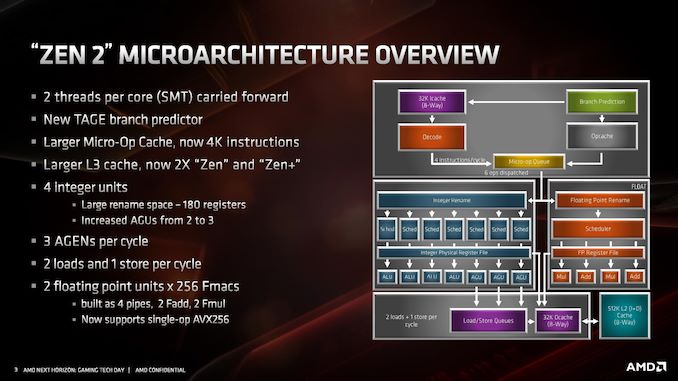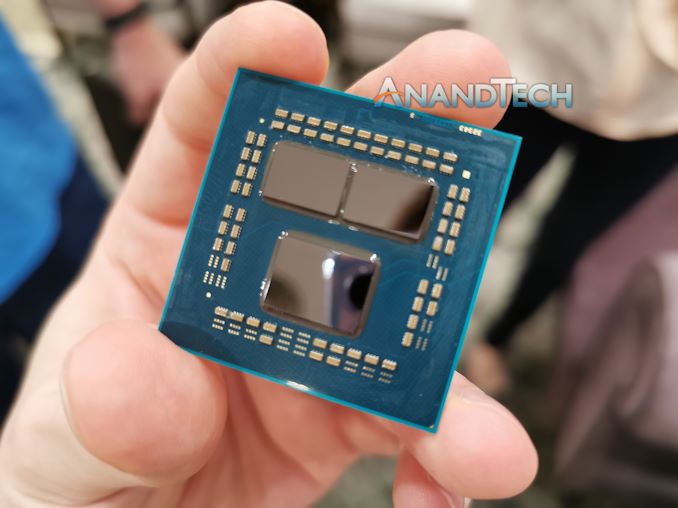AMD Zen 2 Microarchitecture Analysis: Ryzen 3000 and EPYC Rome
by Dr. Ian Cutress on June 10, 2019 7:22 PM EST- Posted in
- CPUs
- AMD
- Ryzen
- EPYC
- Infinity Fabric
- PCIe 4.0
- Zen 2
- Rome
- Ryzen 3000
- Ryzen 3rd Gen
Building a core like Zen 2 requires more than just building a core. The interplay between the core, the SoC design, and then the platform requires different internal teams to come together to create a level of synergy that working separately lacks. What AMD has done with the chiplet design and Zen 2 shows great promise, not only in taking advantage of smaller process nodes, but also driving one path on the future of compute.
When going down a process node, the main advantages are lower power. That can be taken in a few ways: lower power for operation at the same performance, or more power budget to do more. We see this with core designs over time: as more power budget is opened or different units within the core get more efficient, that extra power is used to drive cores wider, hopefully increasing raw instruction rate. It’s not an easy equation to solve, as there are many trade-offs: one such example in the Zen 2 core is the relationship between the reduced L1 I-cache that has allowed AMD to double the micro-op cache, which overall AMD expects to help with performance and power. Going into the minutae of what might be possible, at least at a high level, is like playing with Lego for these engineers.
All that being said, Zen 2 looks a lot like Zen. It is part of the same family, which means it looks very similar. What AMD has done with the platform, enabling PCIe 4.0, and putting the design in place to rid the server processors of the NUMA-like environment is going to help AMD in the long run. The outlook is good for AMD here, depending on how high it can drive the frequency of the server parts, but Zen 2 plus Rome is going to remove a good number of questions that customers on the fence had about Zen.
Overall AMD has quoted a +15% core performance improvement with Zen 2 over Zen+. With the core changes, at a high level, that certainly looks feasible. Users focused on performance will love the new 16-core Ryzen 9 3950X, while the processor seems nice an efficient at 105W, so it will be interesting so see what happens at lower power. We're also anticipating a very strong Rome launch here over the next few months, especially with features like double FP performance and QoS, and the raw multithreading performance of 64 cores is going to be an interesting disruptor to the market, especially if priced effectively. We’ll be getting the hardware on hand here soon to present our findings when the processors are launched on July 7th.












216 Comments
View All Comments
Korguz - Monday, June 17, 2019 - link
im glad im not the only one that sees this...Qasar - Monday, June 17, 2019 - link
korguz, you aren't the only one that sees it.Xyler94, i dont hate intel.. but i am sick of what they have done so far to the cpu industry, sticking the mainstream with quad cores for how many years ? i would of loved to get a 6 or 8 core intel chip, but the cost of the platform, made it out of my reach. the little performance gains year over year, come on, thats the best intel can do with all the money they have ?? and the constant lies about 10nm.... then Zen is released and what was it, less then 2 months later, intel all of a sudden has more then 4 cores for the mainstream, and even more cores for the HEDT ? my next upgrade at this point, looks to be zen 2.. but i am waiting till the 7th, to read the reviews. hstewart does glorify intel any chance he can, and it just looks so stupid, cause some one calls him out on it.. and he seems to pretty much vanish from that convo
HStewart - Thursday, June 13, 2019 - link
Notice that I mention unless they change it from dual 128 bit.Targon - Thursday, June 13, 2019 - link
Socket AM4 is limited to a dual-channel memory controller, because you need more pins to add more memory channels. The same applies to the number of PCI Express lanes as well. The only way around this would be to use one of the abilities of Gen-Z where the CPU would just talk to the Gen-Z bus, at which point, dedicated pins for memory and PCI Express could be replaced by a very wide and fast connection to the system bus/fabric. Since that would require a new motherboard and for the CPU to be designed around it, why bother with socket AM4 at that point?Korguz - Thursday, June 13, 2019 - link
why bother?? um upgrade ability ? maybe not quite needed ? the things you suggest, sound like they would be a little expensive to implement. if you need more memory bandwidth and pcie lanes.. grab a TR board and a lower end cpu....austinsguitar - Monday, June 10, 2019 - link
Thank you Ian for this write up. :)megapleb - Monday, June 10, 2019 - link
Why does the 3600X have power consumption of 95W, and the 3700X, with two more cores, four more threads, and the same frequency max, consume only 65W? I'm guessing those two got switched around?anonomouse - Monday, June 10, 2019 - link
higher sustained base clock drives up the tdpmegapleb - Monday, June 10, 2019 - link
200Mhz extra base increases power consumption by 46%? I would have though max power consumption would be all cores operating at maximum frequency so the base would have nothing to do with it?scineram - Tuesday, June 11, 2019 - link
Nobody said anything about power consumption.